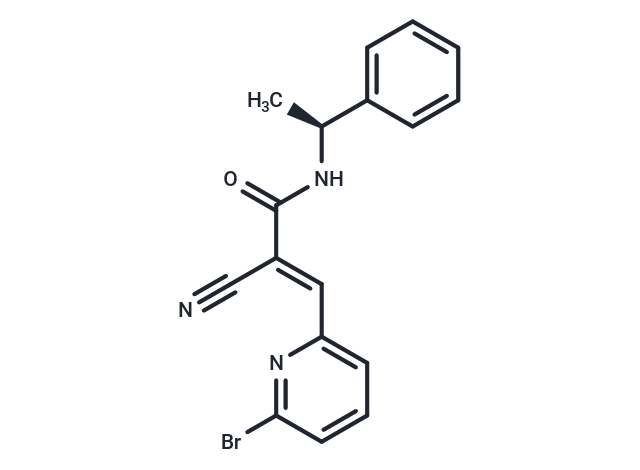Shopping Cart
- Remove All
 Your shopping cart is currently empty
Your shopping cart is currently empty

WP1066 is a inhibitor of JAK2 (IC50: 2.30 μM) and STAT3 (IC50: 2.43 μM) in HEL cells; shows activity to JAK2, STAT3/5, and ERK1/2, not JAK1 and JAK3. WP1066 has been used in trials studying the treatment of Melanoma, Brain Cancer, Solid Tumors, and Central Nervous System Neoplasms.

| Pack Size | Price | Availability | Quantity |
|---|---|---|---|
| 5 mg | $44 | In Stock | |
| 10 mg | $74 | In Stock | |
| 25 mg | $133 | In Stock | |
| 50 mg | $225 | In Stock | |
| 100 mg | $315 | In Stock | |
| 500 mg | $768 | In Stock | |
| 1 mL x 10 mM (in DMSO) | $48 | In Stock |
| Description | WP1066 is a inhibitor of JAK2 (IC50: 2.30 μM) and STAT3 (IC50: 2.43 μM) in HEL cells; shows activity to JAK2, STAT3/5, and ERK1/2, not JAK1 and JAK3. WP1066 has been used in trials studying the treatment of Melanoma, Brain Cancer, Solid Tumors, and Central Nervous System Neoplasms. |
| Targets&IC50 | JAK2:2.3 μM, STAT3:2.43 μM |
| In vitro | WP1066 dose-dependently and significantly inhibits the growth of HEL cells harboring the JAK2 V617F mutation (IC20/IC50/IC80: 0.8/2.3/3.8 μM). In acute leukemia, HEL cells expressing the JAK2 V617F mutation, WP1066 (0.5-4.0 μM) inhibits the phosphorylation of JAK2, STAT3, STAT5, and ERK1/2, without affecting the phosphorylation of JAK1 and JAK3. WP1066 (0.5-3.0 μM) dose-dependently suppresses the proliferation of AML cells derived from patients, as well as OCIM2 and K562 AML cell lines. At concentrations of 0.5, 1.0, 2.0, 3.0, or 4.0 μM, WP1066 dose-dependently reduces the protein levels of JAK2 and pJAK2, along with the phosphorylation levels of STAT3, STAT5, and AKT in OCIM2 and K562 cells. WP1066 (1, 2, or 3 μM) activates procaspase-3 and cleaves PARP, inducing apoptosis in OCIM2 and K562 cells in a dose-dependent manner. WP1066 (2 μM) inhibits the proliferation of OCIM2 cells by inducing the accumulation of cells in the G0-G1 phase of the cell cycle. At 5 μM, WP1066 prevents STAT3 phosphorylation, and at 2.5 μM, it significantly inhibits the survival and proliferation of Caki-1 and 786-O renal cancer cells. WP1066 (5 μM) also suppresses the expression of HIF1α and HIF2α and the production of VEGF in Caki-1 and 786-O renal cancer cells. |
| In vivo | In Caki-1 xenografted mice, continuous administration of WP1066 (40 mg/kg/day, p.o.) for 19 days significantly inhibited tumor growth while concurrently reducing phosphorylated STAT3 immunostaining and lowering the length of CD34-positive blood vessels. |
| Cell Research | The 3, [4,5-dimethylthiazol-2-yl]-5-[3-carboxymethoxyphenyl]-2-[4-sulfophenyl]-2H-tetrazolium (MTT) assay is done using an MTT-based cell proliferation/cytotoxicity assay system. Briefly, fresh low-density peripheral blood cells and various cell lines at the logarithmic phase of their growth are washed twice in RPMI 1640 containing 10% FCS and counted in a hemocytometer. Cell viability is assessed by the trypan blue (0.1%) staining method. Equal numbers of viable cells (5 × 104 per well) are incubated in a total volume of 100 μL of RPMI 1640 supplemented with 10% FCS alone or with WP1066 at increasing concentrations; the incubations are continued for up to 72 h in 96-well flat-bottomed plates at 37 °C in a humidified 5% CO2 atmosphere. Experiments for each condition are done in triplicate. After incubation, 20 μL of CellTiter96 One Solution Reagent are added to each well. The plates are then incubated for an additional 60 min at 37 °C in a humidified 5% CO2 atmosphere. Immediately after incubation, absorbance is read using a 96-well plate reader at a wavelength of 490 nm.(Only for Reference) |
| Molecular Weight | 356.22 |
| Formula | C17H14BrN3O |
| Cas No. | 857064-38-1 |
| Smiles | C[C@H](NC(=O)C(=C\c1cccc(Br)n1)\C#N)c1ccccc1 |
| Relative Density. | 1.425 g/cm3 |
| Storage | store at low temperature,keep away from direct sunlight | Powder: -20°C for 3 years | In solvent: -80°C for 1 year | Shipping with blue ice. | |||||||||||||||||||||||||||||||||||
| Solubility Information | DMSO: 40 mg/mL (112.29 mM) Ethanol: < 1 mg/mL (insoluble or slightly soluble) | |||||||||||||||||||||||||||||||||||
Solution Preparation Table | ||||||||||||||||||||||||||||||||||||
DMSO
| ||||||||||||||||||||||||||||||||||||

Copyright © 2015-2024 TargetMol Chemicals Inc. All Rights Reserved.